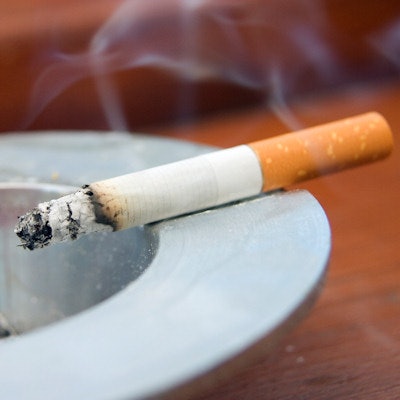
Heavy smoking may affect the optimal timing for implant loading, according to a recent study. Researchers found that heavy smoking slowed the healing of posterior mandible implants but did not affect the implant survival rate.
The study results also indicated that heavy smoking promoted the loss of marginal bone and the further development of dental pockets.
"These results imply that it might be of importance to select the right time point to apply the implant loading for heavy smokers," wrote Cong Sun, DDS, and co-authors in the Journal of Oral Implantology (December 2016, Vol. 42:6, pp. 477-483).
Dr. Sun and colleagues are dentists in the oral department at the First Affiliated Hospital of Xi'an Jiaotong University in China.
Effects of smoking
Previous studies have indicated that smokers have higher implant failure rates and a higher risk of postoperative infection, as well as greater marginal bone loss. However, further statistical analysis has suggested that smoking only significantly affects the survival of implants inserted in the maxilla, and some reports suggest that smoking does not significantly affect the survival of implants placed in the mandible.
"Currently, informative studies on the influence of heavy smoking on single-tooth implants placed at the posterior mandibles of smokers are lacking," the authors wrote. "However, this information/knowledge is needed for surgeons to make informed decisions and refine treatment plans to optimize outcomes."
Therefore, the researchers sought to evaluate postsurgery bone healing and peri-implant tissue response in heavy smokers who received dental implants because of partially edentulous posterior mandibles.
The study included 16 heavy smokers and 16 nonsmokers, all of whom were male and ages 25 to 65. Among the patients, 45 dental implants (regular neck, 4.8 x 10 mm, Straumann) were placed.
Heavy smokers were defined as those who smoked one or more packs of cigarettes, with 20 cigarettes per pack, per day for 10 years. Nonsmokers had no smoking history.
Since most implant failures occur during the second surgery phase and the first year of functional loading, the researchers evaluated implant stability at the following times:
- During the first 12 weeks after surgery before loading
- During the first year after loading
They monitored the implant stability quotient (ISQ) for the first 12 weeks after implantation. Changes in the ISQ during bone healing before loading reflect changes at the implant-bone interface, the authors explained.
In both the smokers and nonsmokers, the stability quotient immediately decreased from the initial measurements taken after surgery, with the lowest ISQ reached around two weeks after surgery. However, healing patterns between the groups diverged between two and 12 weeks.
“These results imply that it might be of importance to select the right time point to apply the implant loading for heavy smokers.”
"Although at 12 weeks after surgery, the ISQ values for both groups reached the respective initial implant stabilities achieved immediately after surgery, the ISQ values for the nonsmoker group were significantly higher than those for the heavy smoker group at 3, 4, 6, and 8 weeks after surgery," the authors wrote. "This indicated that heavy smoking negatively affected the process of osteointegration."
Additionally, examination of jaw marrow samples obtained from the patients and evaluated via an in vitro mineralization test indicated that samples from nonsmokers exhibited a better ability to form calcified nodules and mineralization than those from smokers. A reduced capability to mineralize would slow osseointegration, the authors noted.
After three months, denture restorations were placed for all the implants and were successful in all cases.
"In contrast to the high implant failure rates within one year postloading for heavy smokers reported by other researchers, our cumulative implant survival rate of 100% at the end of one year postloading might be attributed to the fact that the loading was applied after the biological stability of implants had reached the stationary phase," the authors wrote.
At six and 12 months post-loading, the researchers found that marginal bone loss and probing depth were significantly higher in the smokers compared with the nonsmokers, while the modified sulcus bleeding index and modified plaque index were not significantly different between the groups. However, the authors also found that the modified sulcus bleeding index in the smokers was significantly higher at 12 months after loading than at six months.
"This suggested that after a short loading time, the heavy smokers had a greater chance of developing inflammation in the surrounding soft tissue," the authors wrote. "This inflammation could have an unfavorable influence on implant prognosis."
Impact on osseointegration
The authors noted that their results differed in some ways from a previous study that found that smoking had no significant impact on osseointegration or marginal bone loss. These results may have occurred because of the use of different implants or some other unknown factors, they wrote.
They also noted their study's limitations of a small sample size and short duration, as well as the need for more research.
"Further clinical studies with larger patient populations are warranted to confirm our findings over longer study duration," they concluded.



















